Characteristics of Controlling Factors of Shale Oil Enrichment in Lucaogou Formation, Jimusar Sag
Abstract
1. Introduction
2. Geological Background
3. Samples and Methods
3.1. Samples
3.2. Organic Carbon Content Determination and Programmed Temperature Pyrolysis Analysis
3.3. Separation of Family Components
3.4. Saturated Hydrocarbons Gas Chromatography–Mass Spectrometry
4. Result
4.1. Physical Properties of Shale Oil
4.2. Physical Characteristics of Reservoir
4.2.1. Rock Mineral Composition
4.2.2. Pore Characteristics
4.3. Hydrocarbon Generation Potential of Source Rocks
4.4. Biomarker Compound Characteristics
5. Discussion
5.1. Sources and Storage Conditions of Organic Matter
5.2. Reservoir Properties of Shale
6. Conclusions
Author Contributions
Funding
Data Availability Statement
Conflicts of Interest
References
- Katz, B.; Gao, L.; Little, J.; Zhao, Y.R. Geology still matters—Unconventional petroleum system disappointments and failures. Unconv. Resour. 2021, 1, 18–38. [Google Scholar] [CrossRef]
- Blaizot, M. Worldwide shale-oil reserves: Towards a global approach based on the principles of Petroleum System and the Petroleum System Yield. Bull. Société Géologique Fr. 2017, 188. [Google Scholar] [CrossRef]
- Jia, C.; Zheng, M.; Zhang, Y. Unconventional hydrocarbon resources in China and the prospect of exploration and development. Pet. Explor. Dev. 2012, 39, 139–146. [Google Scholar] [CrossRef]
- Du, J.; He, H.; Li, J.; Yang, T.; Huang, F.; Guo, B.; Yan, W. Progress in China’s tight oil exploration and challenges. China Pet. Explor. 2014, 19, 1. [Google Scholar]
- Jarvie, D.M. Shale resource systems for oil and gas: Part 2—Shale-oil resource systems. In Shale Reservoirs—Giant Resources for the 21st Century; Breyer, J.A., Ed.; AAPG Memoir; American Association of Petroleum Geologists: Tulsa, OK, USA, 2012; Volume 97, pp. 89–119. [Google Scholar] [CrossRef]
- Fang, S.; Song, Y.; Xu, H.; Fan, R.; Liu, L.; Xu, X. Relationship between tectonic evolution and petroleum system formation—Taking the Jimsar Sag of eastern Junggar Basin as an example. Pet. Explor. Dev. 2007, 29, 149–153. [Google Scholar] [CrossRef]
- Cao, Z.; Liu, G.; Kong, Y.; Wang, C.; Niu, Z.; Zhang, J.; Geng, C.; Shan, X.; Wei, Z. Lacustrine tight oil accumulation characteristics: Permian Lucaogou Formation in Jimusaer Sag, Junggar Basin. Int. J. Coal Geol. 2016, 153, 37–51. [Google Scholar] [CrossRef]
- Qiu, Z.; Zou, C.; Dong, D.; Lu, B.; Shi, Z.; Tao, H.; Zhou, J.; Lei, D.; Zhang, C. Petroleum system assessment of conventional-unconventional oil in the Jimusar sag, Junggar basin, Northwest China. J. Unconv. Oil Gas Resour. 2016, 16, 53–61. [Google Scholar] [CrossRef]
- Liu, B.; Bechtel, A.; Gross, D.; Fu, X.; Li, X.; Sachsenhofer, R.F. Middle Permian environmental changes and shale oil potential evidenced by high-resolution organic petrology, geochemistry and mineral composition of the sediments in the Santanghu Basin, Northwest China. Int. J. Coal Geol. 2018, 185, 119–137. [Google Scholar] [CrossRef]
- Wei, Y.; Wu, J.; Liu, S.; Wang, Z.; Luo, Y.; Liu, W. The Characteristics of Microscopic Heterogeneity and Its Influence on Imbibition in Shale Oil Reservoirs in Permian Lucaogou Formation, Jimsar Sag, Junggar Basinjin. In 2023 International Conference on Energy Engineering; Chen, Z., Yang, W., Chen, H., Eds.; Lecture Notes in Electrical Engineering; Springer: Singapore, 2024; Volume 1257, pp. 364–377. [Google Scholar] [CrossRef]
- Carroll, A.R. Upper Permian lacustrine organic facies evolution, southern Junggar basin, NW China. Org. Geochem. 1998, 28, 649–667. [Google Scholar] [CrossRef]
- Gao, G.; Zhang, W.; Xiang, B.; Liu, G.; Ren, J. Geochemistry characteristics and hydrocarbon-generating potential of lacustrine source rock in Lucaogou Formation of the Jimusaer Sag, Junggar Basin. J. Pet. Sci. Eng. 2016, 145, 168–182. [Google Scholar] [CrossRef]
- Liu, B.; Bechtel, A.; Sachsenhofer, R.F.; Gross, D.; Gratzer, R.; Chen, X. Depositional environment of oil shale within the second member of Permian Lucaogou Formation in the Santanghu Basin, Northwest China. Int. J. Coal Geol. 2017, 175, 10–25. [Google Scholar] [CrossRef]
- Yang, Y.; Qiu, L.; Wan, M.; Jia, X.; Cao, Y.; Lei, D.; Qu, C. Depositional model for a salinized lacustrine basin: The Permian Lucaogou Formation, Jimsar Sag, Junggar Basin, NW China. J. Asian Earth Sci. 2019, 178, 81–95. [Google Scholar] [CrossRef]
- Pang, H.; Pang, X.-q.; Dong, L.; Zhao, X. Factors impacting on oil retention in lacustrine shale: Permian Lucaogou Formation in Jimusaer Depression, Junggar Basin. J. Pet. Sci. Eng. 2018, 163, 79–90. [Google Scholar] [CrossRef]
- Su, S.; Jiang, Z.; Shan, X.; Zhang, C.; Zou, Q.; Li, Z.; Zhu, R. The effects of shale pore structure and mineral components on shale oil accumulation in the Zhanhua Sag, Jiyang Depression, Bohai Bay Basin, China. J. Pet. Sci. Eng. 2018, 165, 365–374. [Google Scholar] [CrossRef]
- Qu, C.-S.; Qiu, L.-W.; Cao, Y.-C.; Yang, Y.-Q.; Yu, K.-H. Sedimentary environment and the controlling factors of organic-rich rocks in the Lucaogou Formation of the Jimusar Sag, Junggar Basin, NW China. Pet. Sci. 2019, 16, 763–775. [Google Scholar] [CrossRef]
- Jiang, Y.; Hou, D.; Li, H.; Zhang, Z.; Guo, R. Impact of the Paleoclimate, Paleoenvironment, and Algae Bloom: Organic Matter Accumulation in the Lacustrine Lucaogou Formation of Jimsar Sag, Junggar Basin, NW China. Energies 2020, 13, 1488. [Google Scholar] [CrossRef]
- Wang, Y.; Cao, J.; Tao, K.; Li, E.; Ma, C.; Shi, C. Reevaluating the source and accumulation of tight oil in the middle Permian Lucaogou Formation of the Junggar Basin, China. Mar. Pet. Geol. 2020, 117, 104384. [Google Scholar] [CrossRef]
- Fu, X.; Su, X.; Gong, L.; Wang, Q.; Gao, S.; Xie, Z. Control of faults and fractures on shale oil enrichment. Geoenergy Sci. Eng. 2023, 228, 212080. [Google Scholar] [CrossRef]
- Wang, Y.; Cao, J.; Tao, K.; Zhang, C.; Xiang, B.; Li, E.; Yu, S.; Pan, C. Origin of heavy shale oil in saline lacustrine basins: Insights from the Permian Lucaogou Formation, Junggar Basin. AAPG Bull. 2023, 107, 1553–1579. [Google Scholar] [CrossRef]
- Lathbl, M.A.; Haque, A.E.; Hakimi, M.H.; Lashin, A.; Qadri, S.M.T. Organic geochemical characteristics of the Late Cretaceous coal and carbonaceous shale succession from the Taranaki Basin, New Zealand: Implications for sedimentary environmental setting and petroleum generation potential. Geol. J. 2024, 59, 1703–1723. [Google Scholar] [CrossRef]
- Li, M.Y.; Wu, S.T.; Zhu, R.K.; Hu, S.Y.; Wang, P.W.; Cai, Y.; Zhang, S.R. Heterogeneity and Sedimentary Characteristics of Shale Laminae of Fine-Grained Sediments in Alkaline Lacustrine Strata in the Permian Fengcheng Formation, Mahu Sag, NW China. Energies 2024, 17, 962. [Google Scholar] [CrossRef]
- Wei, L.; Jiangyan, L.; Jihong, L.; Jin, D.; Yang, G.; Yan, Z.; Tingting, L.; Shilong, C. Heterogeneous characteristics and genesis of shale in Chang 7 3 sub member Ordos Basin. Chin. J. Geol. 2025, 60, 484–496. [Google Scholar] [CrossRef]
- Ali, F.; Abbas, S.; Hanif, M.; Zhang, S.; Ahmad, R.; Zhang, Y.; Khan, D.; Lee, E.Y.; Ahmed, M.S.; Fathy, D. Biomarker and Geochemical Evaluation of Source Rock and Crude Oil Extract for Correlation, Depositional Setting and Source Rock Potential in the Indus Basin, Pakistan. J. Geol. Soc. India 2025, 101, 508–521. [Google Scholar] [CrossRef]
- Ari, M.A.I.; Nton, M.E.; Harouna, M. Biomarker geochemistry and oil-oil correlation from reservoir unit oils of the Sokor-1 Formation, Fana low uplift, Termit Basin, southeastern Niger. J. Afr. Earth Sci. 2025, 223, 105522. [Google Scholar] [CrossRef]
- Bagheri, S.; Pourbagher, M.; Shourab, M. Geochemical evaluation of Sarvak oil reservoir using biomarkers, carbon isotope and trace element: A case study from Southwest Iran. J. Nat. Gas Geosci. 2024, 9, 281–302. [Google Scholar] [CrossRef]
- Mohialdeen, I.M.J.; Hakimi, M.H.; Fatah, S.S.; Abdula, R.A.; Khanaqa, P.A.; Lathbl, M.A.; Naseem, W. Organic Geochemistry and 1-D Basin Modeling of the Late Triassic Baluti Formation: Implication of Shale Oil Potential in the Kurdistan Region of Iraq. ACS Omega 2024, 9, 7085–7107. [Google Scholar] [CrossRef] [PubMed]
- AlSaif, M.; Atwah, I.; Becker, M.; Moldowan, J.M.; Zumberge, A.; Marcantonio, F. Diamondoids, biomarkers, and chemofacies: Uniting insights on hydrocarbon maturation and migration in the Cline Shale, Midland Basin. Org. Geochem. 2025, 203, 104953. [Google Scholar] [CrossRef]
- Hu, T.; Liu, Y.; Jiang, F.J.; Pang, X.Q.; Wang, Q.F.; Zhou, K.; Wu, G.Y.; Jiang, Z.X.; Huang, L.L.; Jiang, S.; et al. A novel method for quantifying hydrocarbon micromigration in heterogeneous shale and the controlling mechanism. Energy 2024, 288, 129712. [Google Scholar] [CrossRef]
- Wang, J.P.; Li, B.H.; Shao, H.M.; Zhang, Y.H.; Zhang, C.J.; Gao, B.; Jiang, Z.X.; Qiu, H.Y.; Li, X.H. Geochemical and Reservoir Characteristics of the Middle-High-Mature Shale of the Jurassic Lianggaoshan Formation in Northeast Sichuan Basin and Their Influence on Shale Oil Enrichment. ACS Omega 2025, 10, 14094–14114. [Google Scholar] [CrossRef]
- Zhu, Z.W.; Fu, Q.; Hu, Z.Q.; Duan, H.L.; Yang, B.L.; Xing, L.L.; Chen, G. Pore Structure and Heterogeneity in the Lacustrine Shale of the Second Member of the Paleogene Funing Formation, Subei Basin, China. Minerals 2024, 14, 1248. [Google Scholar] [CrossRef]
- Allen, M.; ªengör, A.M.C.; Natal’In, B. Junggar, Turfan and Alakol basins as Late Permian to? Early Triassic extensional structures in a sinistral shear zone in the Altaid orogenic collage, Central Asia. J. Geol. Soc. 1995, 152, 327–338. [Google Scholar] [CrossRef]
- Xiao, W.; Han, C.; Yuan, C.; Sun, M.; Lin, S.; Chen, H.; Li, Z.; Li, J.; Sun, S. Middle Cambrian to Permian subduction-related accretionary orogenesis of Northern Xinjiang, NW China: Implications for the tectonic evolution of central Asia. J. Asian Earth Sci. 2008, 32, 102–117. [Google Scholar] [CrossRef]
- Boles, J.R.; Eichhubl, P.; Garven, G.; Chen, J. Evolution of a hydrocarbon migration pathway along basin-bounding faults: Evidence from fault cement. AAPG Bull. 2004, 88, 947–970. [Google Scholar] [CrossRef]
- Kuang, L.; Gao, G.; Xiang, B.; Wang, X.; Wang, C.; Liu, G. Lowest limit of organic carbon content in effective source rocks from Lucaogou Formation in Jimusar Sag. Pet. Geol. Exp. 2014, 36, 224–229. [Google Scholar] [CrossRef]
- Li, K.; Xi, K.; Cao, Y.; Wang, Y.; Lin, M. Genesis of granular calcite in lacustrine fine-grained sedimentary rocks and its indication to volcanic-hydrothermal events: A case study of Permian Lucaogou Formation in Jimusar Sag, Junggar Basin, NW China. Pet. Explor. Dev. 2023, 50, 541–552. [Google Scholar] [CrossRef]
- Carr, A.D. Suppression and retardation of vitrinite reflectance, part 1. Formation and significance for hydrocarbon generation. J. Pet. Geol. 2000, 23, 313–343. [Google Scholar] [CrossRef]
- Gale, J.F.W.; Laubach, S.E.; Olson, J.E.; Eichhubl, P.; Fall, A. Natural fractures in shale: A review and new observations. AAPG Bull. 2014, 98, 2165–2216. [Google Scholar] [CrossRef]
- Zhang, Y.; Zeng, L.; Luo, Q.; Zhu, R.; Pan, S.; Dai, Q.; Shi, J.; Qin, J.; Xu, X. Effects of diagenesis on natural fractures in tight oil reservoirs: A case study of the Permian Lucaogou Formation in Jimusar Sag, Junggar Basin, NW China. Geol. J. 2020, 55, 6562–6579. [Google Scholar] [CrossRef]
- Liu, C.; Liu, K.; Wang, X.; Zhu, R.; Wu, L.; Xu, X. Chemo-sedimentary facies analysis of fine-grained sediment formations: An example from the Lucaogou Fm in the Jimusaer sag, Junggar Basin, NW China. Mar. Pet. Geol. 2019, 110, 388–402. [Google Scholar] [CrossRef]
- Standardization Administration of China. GB/T 19145-2022—Determination for Total Organic Carbon in Sedimentary Rock; China Standard Press: Beijing, China, 2022. [Google Scholar]
- Standardization Administration of China. GB/T 18062-2012—Rock Pyrolysis Analysis; China Standard Press: Beijing, China, 2012. [Google Scholar]
- National Energy Administration. SY/T 5118-2021—Determination of Extractive Content in Rocks; Petroleum Industry Press: Beijing, China, 2022. [Google Scholar]
- National Energy Administration. SY/T 5119-2016—Analysis of Soluble Organic Matter and Crude Oil Components in Rocks; Petroleum Industry Press: Beijing, China, 2016. [Google Scholar]
- Standardization Administration of China. GB/T 18606-2017—The Test Method for Biomarkers in Sediment and Crude Oil by GC–MS; China Standard Press: Beijing, China, 2017. [Google Scholar]
- Tang, Y.; Wang, X.; Wang, T.; Hei, C.; Liang, S.; Cheng, H. Reconstruction of sedimentary paleoenvironment of Permian Lucaogou Formation and its implications for the organic matter enrichment in south-eastern Junggar Basin, China. Front. Earth Sci. 2024, 18, 526–537. [Google Scholar] [CrossRef]
- Dow, W.G. Kerogen studies and geological interpretations. J. Geochem. Explor. 1977, 7, 79–99. [Google Scholar] [CrossRef]
- Qiao, J.; Luo, Q.; Zhang, K.; Zhang, G.; Duan, J.; Wang, D.; Yu, H.; Wang, S.; Qu, Y.; Kopaevich, L. Geochemistry and organic petrography of the Middle Permian Lucaogou alkaline lacustrine oil shale in the southern Junggar Basin, China: Implications for formation conditions and organic matter accumulation. Int. J. Coal Geol. 2023, 268, 104198. [Google Scholar] [CrossRef]
- Moldowan, J.M.; Sundararaman, P.; Schoell, M. Sensitivity of biomarker properties to depositional environment and/or source input in the Lower Toarcian of SW-Germany. Org. Geochem. 1986, 10, 915–926. [Google Scholar] [CrossRef]
- Liu, S.; Gao, G.; Jin, J.; Gang, W.; Xiang, B. Source rock with high abundance of C28 regular sterane in typical brackish-saline lacustrine sediments: Biogenic source, depositional environment and hydrocarbon generation potential in Junggar Basin, China. J. Pet. Sci. Eng. 2022, 208, 109670. [Google Scholar] [CrossRef]
- Kodner, R.B.; Pearson, A.; Summons, R.E.; Knoll, A.H. Sterols in red and green algae: Quantification, phylogeny, and relevance for the interpretation of geologic steranes. Geobiology 2008, 6, 411–420. [Google Scholar] [CrossRef]
- De Almeida, L.T.G.; Brito, A.S.; Cioccari, G.M.; De Souza, A.A.; Mizusaki, A.M.P.; De Lima, S.G. Lipid biomarker profile of the Permian organic-rich shales (Irati Formation) in the northernmost of Parana Basin, Brazil. An. Acad. Bras. Ciências 2024, 96, e20230970. [Google Scholar] [CrossRef] [PubMed]
- Pan, Y.; Huang, Z.; Guo, X.; Li, T.; Zhao, J.; Li, Z.; Qu, T.; Wang, B.; Fan, T.; Xu, X. Lithofacies types, reservoir characteristics, and hydrocarbon potential of the lacustrine organic-rich fine-grained rocks affected by tephra of the permian Lucaogou formation, Santanghu basin, western China. J. Pet. Sci. Eng. 2022, 208, 109631. [Google Scholar] [CrossRef]
- Meng, Z.; Liu, Y.; Jiao, X.; Ma, L.; Zhou, D.; Li, H.; Cao, Q.; Zhao, M.; Yang, Y. Petrological and organic geochemical characteristics of the Permian Lucaogou Formation in the Jimsar Sag, Junggar Basin, NW China: Implications on the relationship between hydrocarbon accumulation and volcanic-hydrothermal activities. J. Pet. Sci. Eng. 2022, 210, 110078. [Google Scholar] [CrossRef]
- Cao, J.; Xia, L.; Wang, T.; Zhi, D.; Tang, Y.; Li, W. An alkaline lake in the Late Paleozoic Ice Age (LPIA): A review and new insights into paleoenvironment and petroleum geology. Earth-Sci. Rev. 2020, 202, 103091. [Google Scholar] [CrossRef]
- Yang, Y.; Qiu, L.; Cao, Y.; Chen, C.; Lei, D.; Wan, M. Reservoir quality and diagenesis of the Permian Lucaogou Formation tight carbonates in Jimsar Sag, Junggar Basin, West China. J. Earth Sci. 2017, 28, 1032–1046. [Google Scholar] [CrossRef]
- Naseem, W.; Jan, I.U.; Mustahpa, K.A.; Hakimi, M.H.; Ahmed, S.; Kahal, A.Y. The Early Cretaceous Sembar Formation, Southern Indus Basin, Pakistan: Biomarkers and Trace Element Distributions to Investigate the Sedimentary Palaeoenvironment and Organic Matter Input. ACS Omega 2024, 9, 39430–39451. [Google Scholar] [CrossRef] [PubMed]
- Xie, W.; Wang, M.; Wang, H.; Ma, R.; Duan, H. Diagenesis of shale and its control on pore structure, a case study from typical marine, transitional and continental shales. Front. Earth Sci. 2021, 15, 378–394. [Google Scholar] [CrossRef]
- Liu, H.; Zhang, S.; Song, G.; Xuejun, W.; Teng, J.; Wang, M.; Bao, Y.; Yao, S.; Wang, W.; Zhang, S. Effect of shale diagenesis on pores and storage capacity in the Paleogene Shahejie Formation, Dongying Depression, Bohai Bay Basin, east China. Mar. Pet. Geol. 2019, 103, 738–752. [Google Scholar] [CrossRef]
- Xu, W.; Yang, D.; Yu, D.; Xin, Z.; Zhao, D.; Wang, H.; Gu, X.; Zhao, X.; Wu, J.; Wu, F. Characterizing the vertical heterogeneity and optimizing the horizontal well landing window in shale oil reservoirs: Case Studies in the Jiyang Depression. In Proceedings of the Unconventional Resources Technology Conference, Houston, TX, USA, 17–19 June 2024; pp. 1146–1162. [Google Scholar]
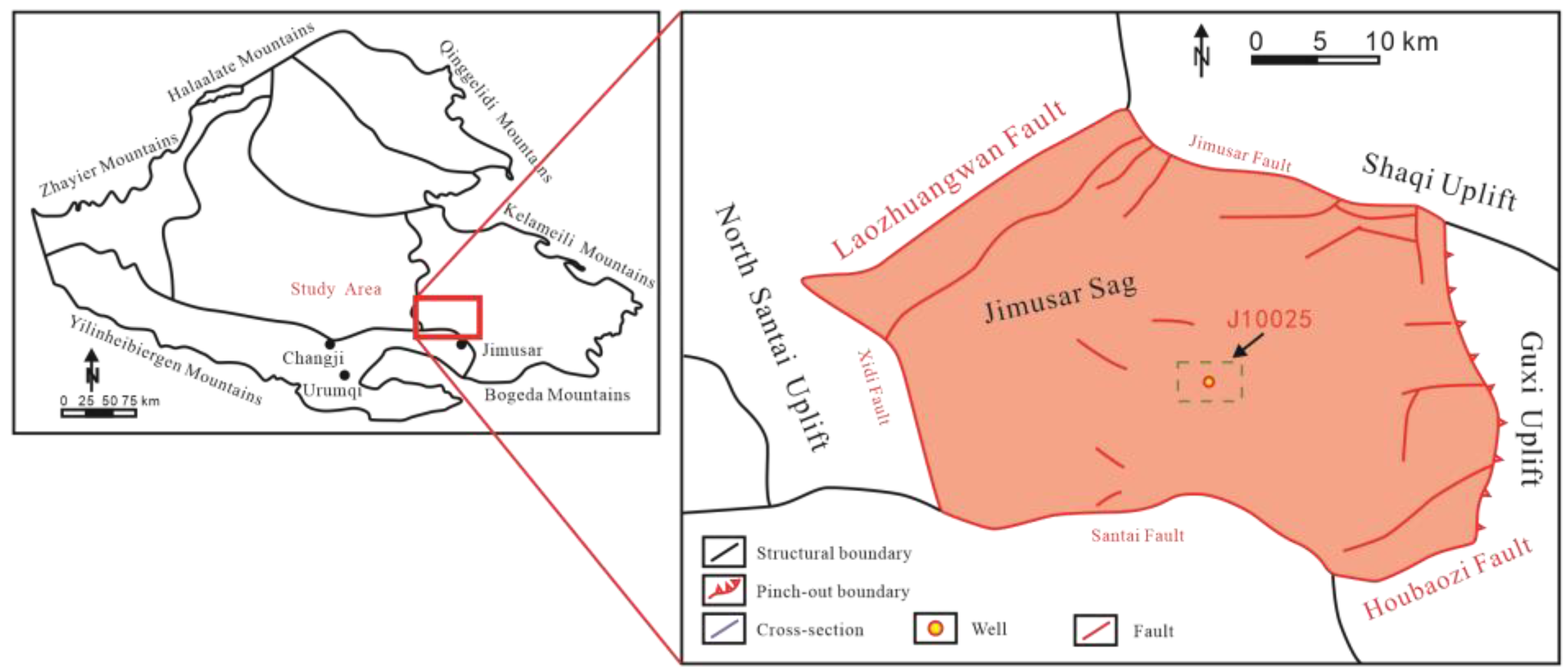

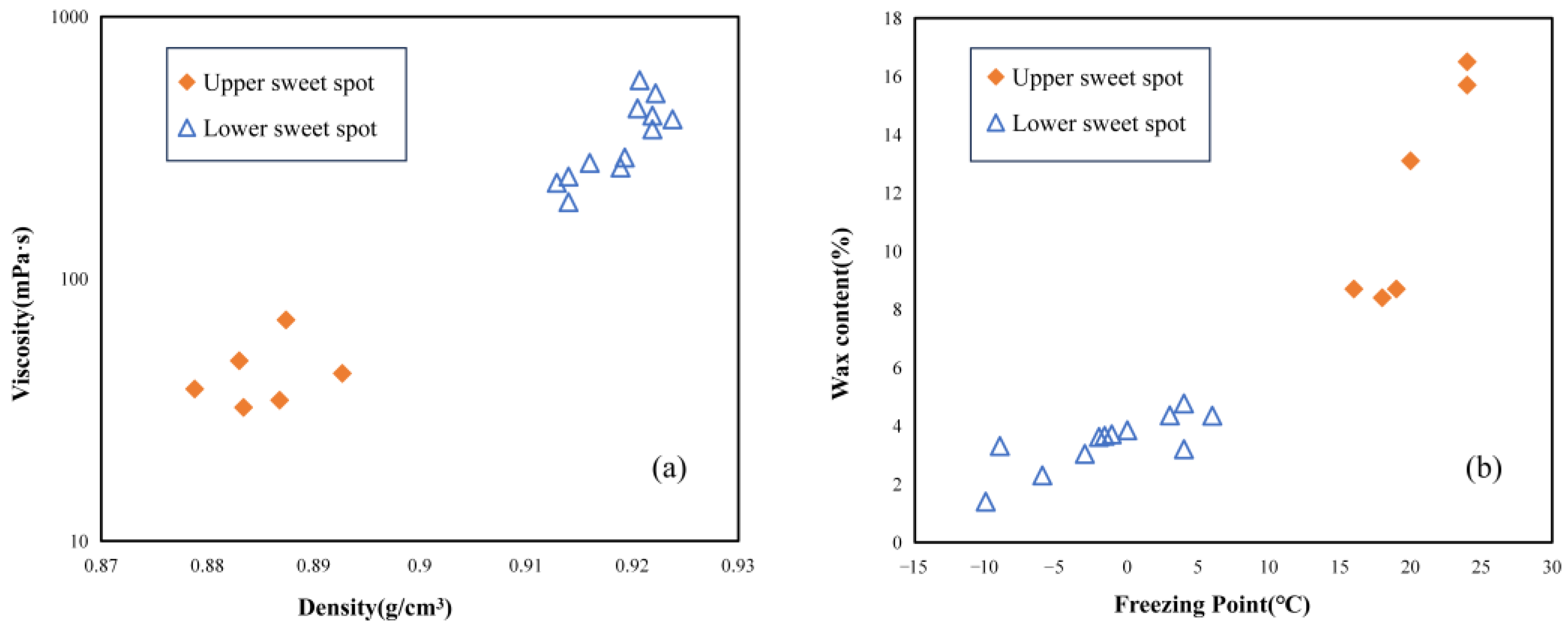
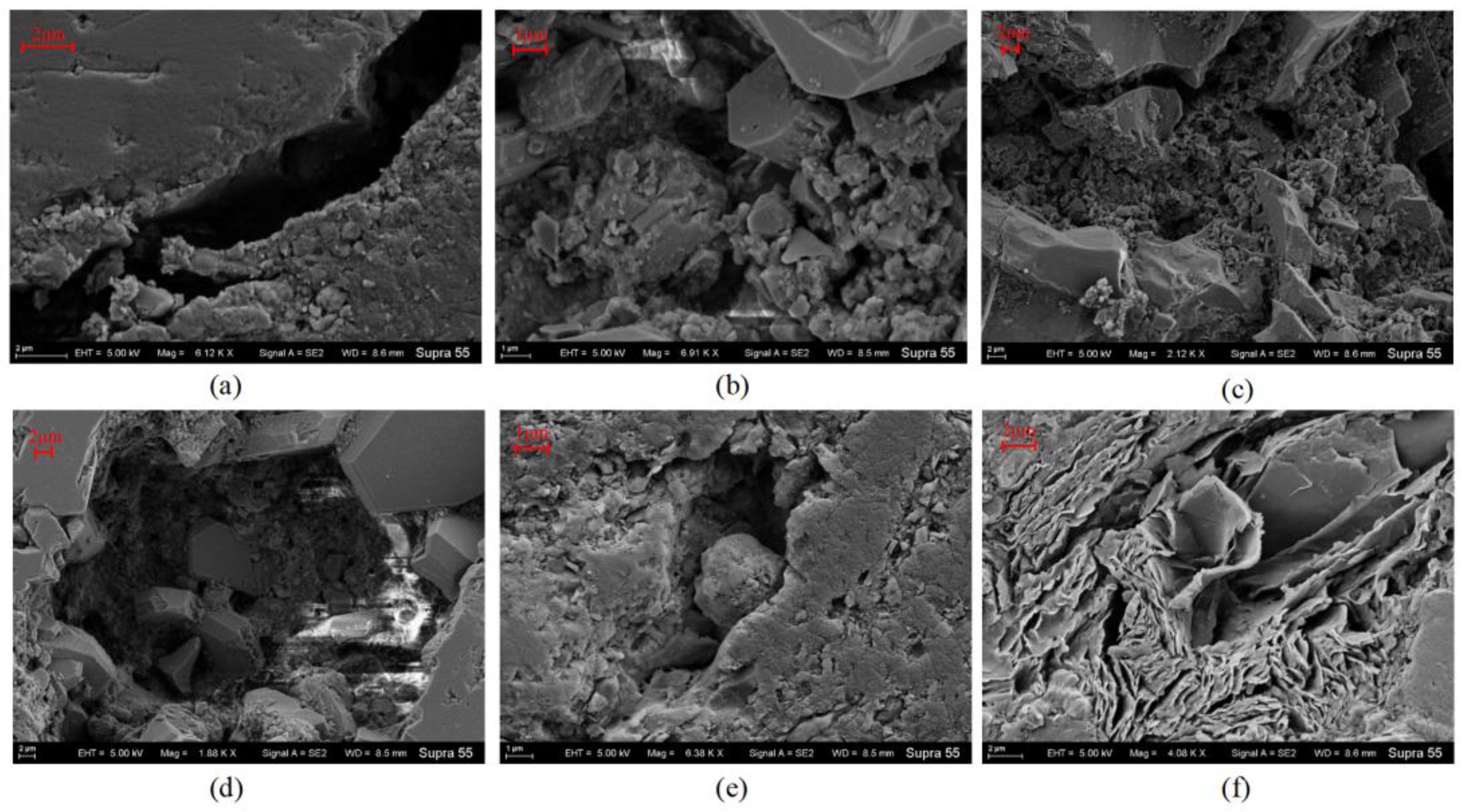
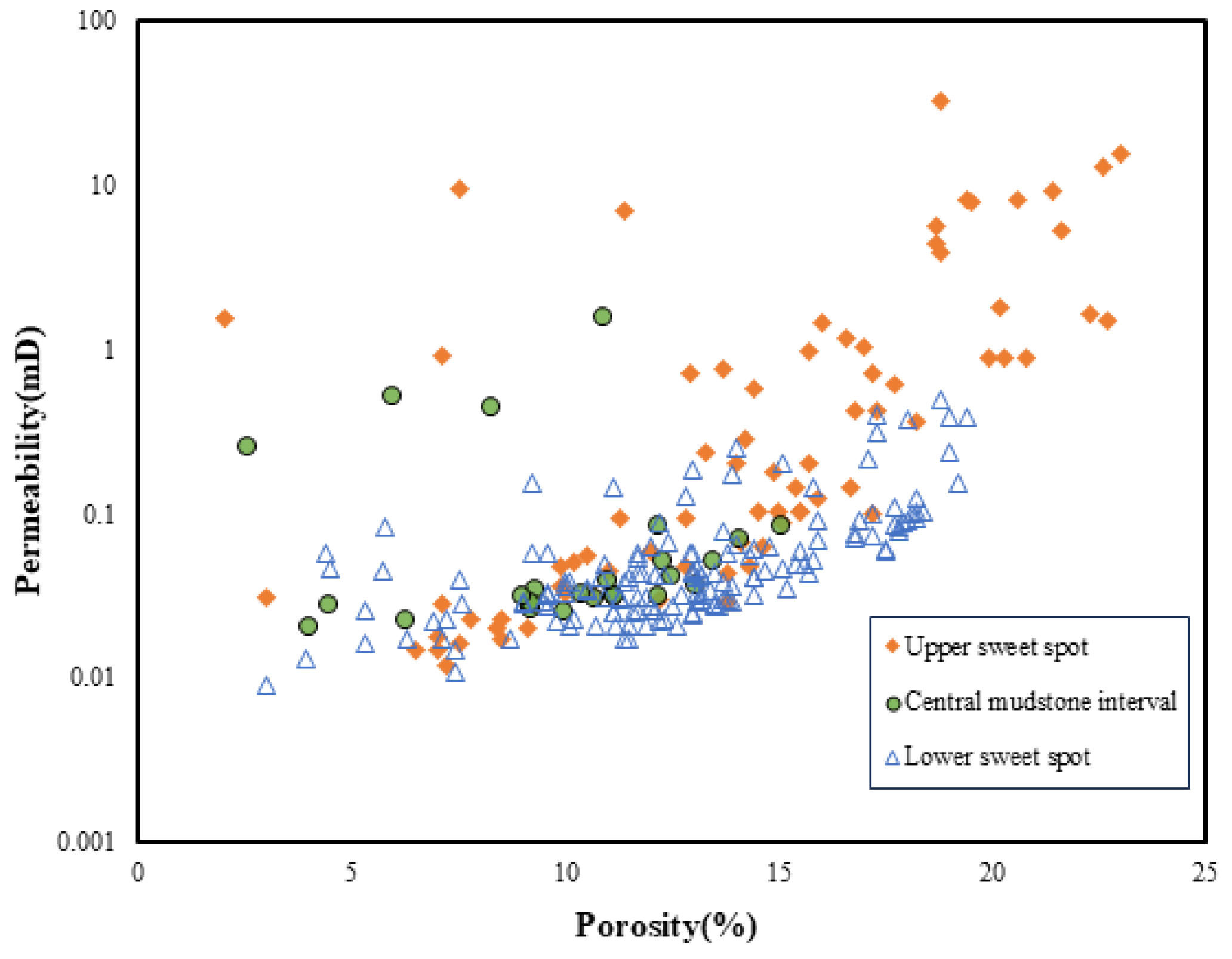
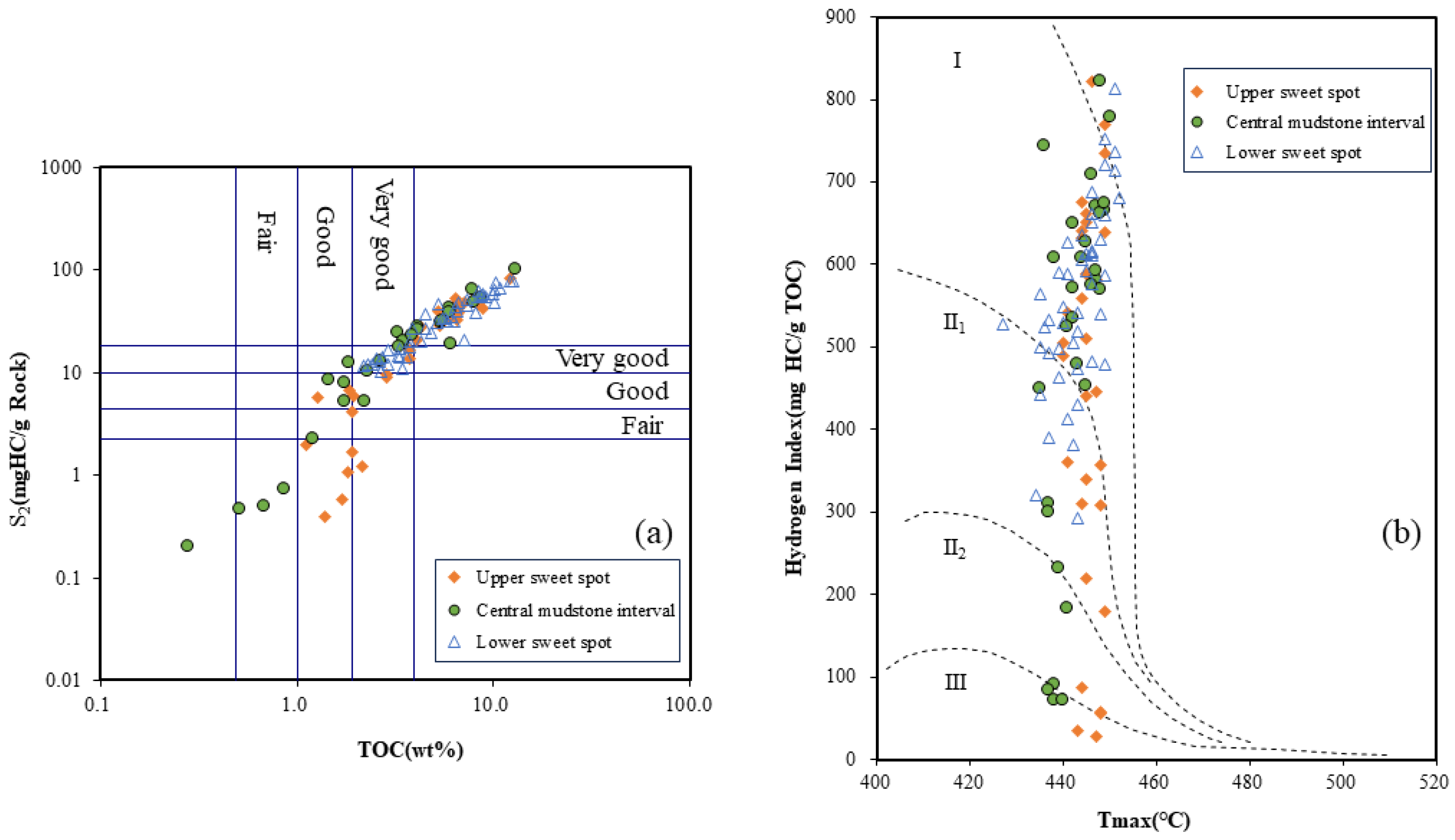

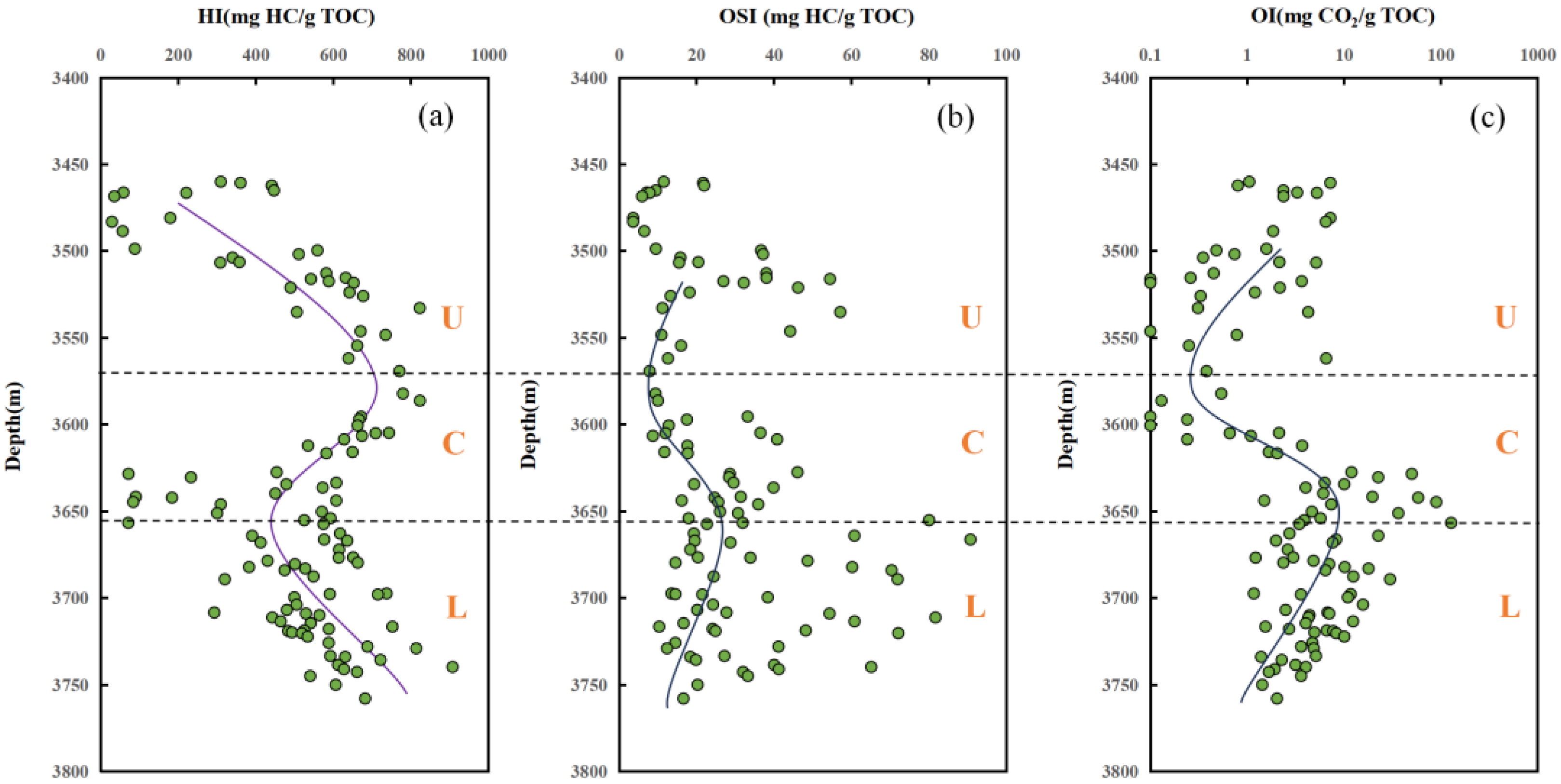
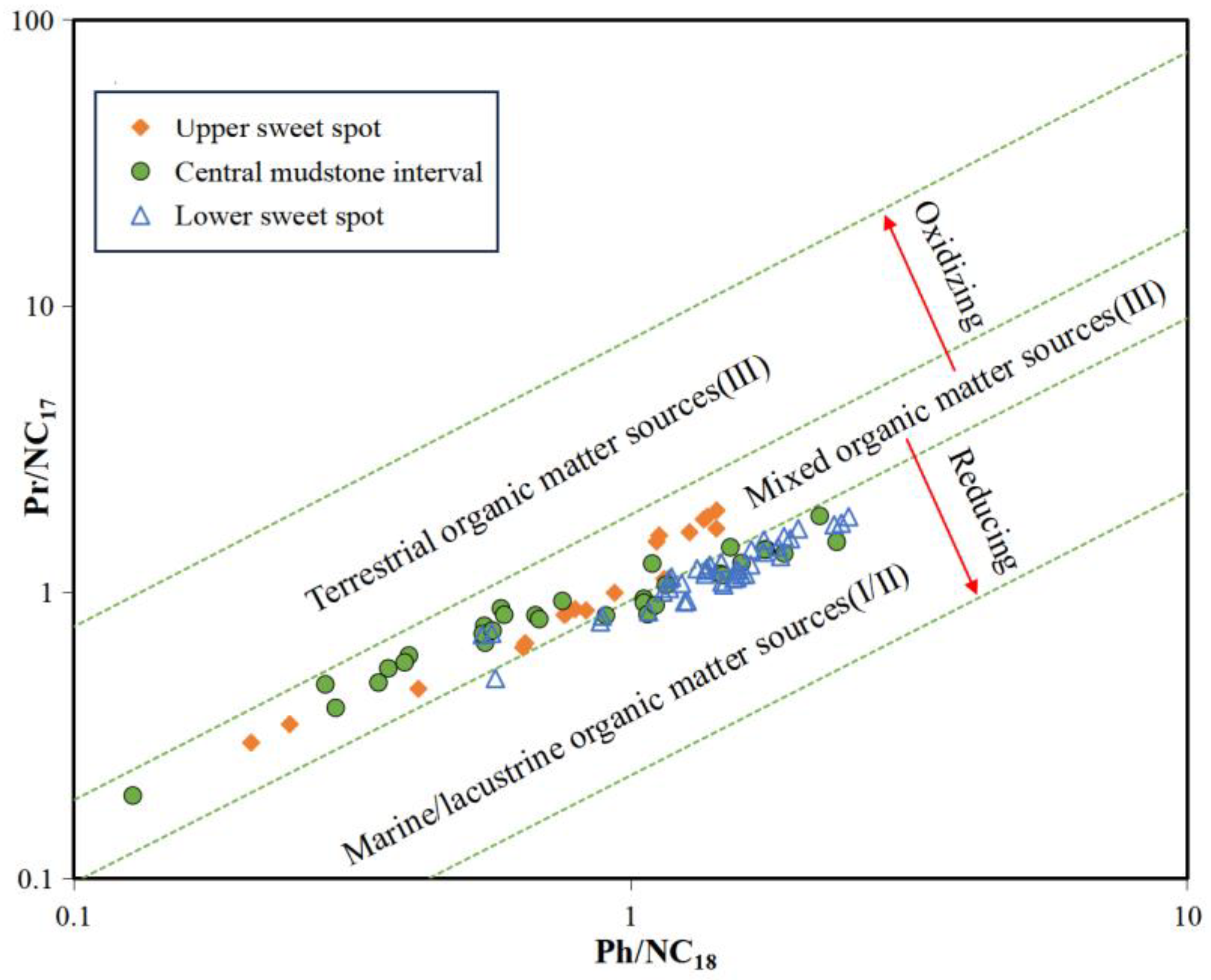
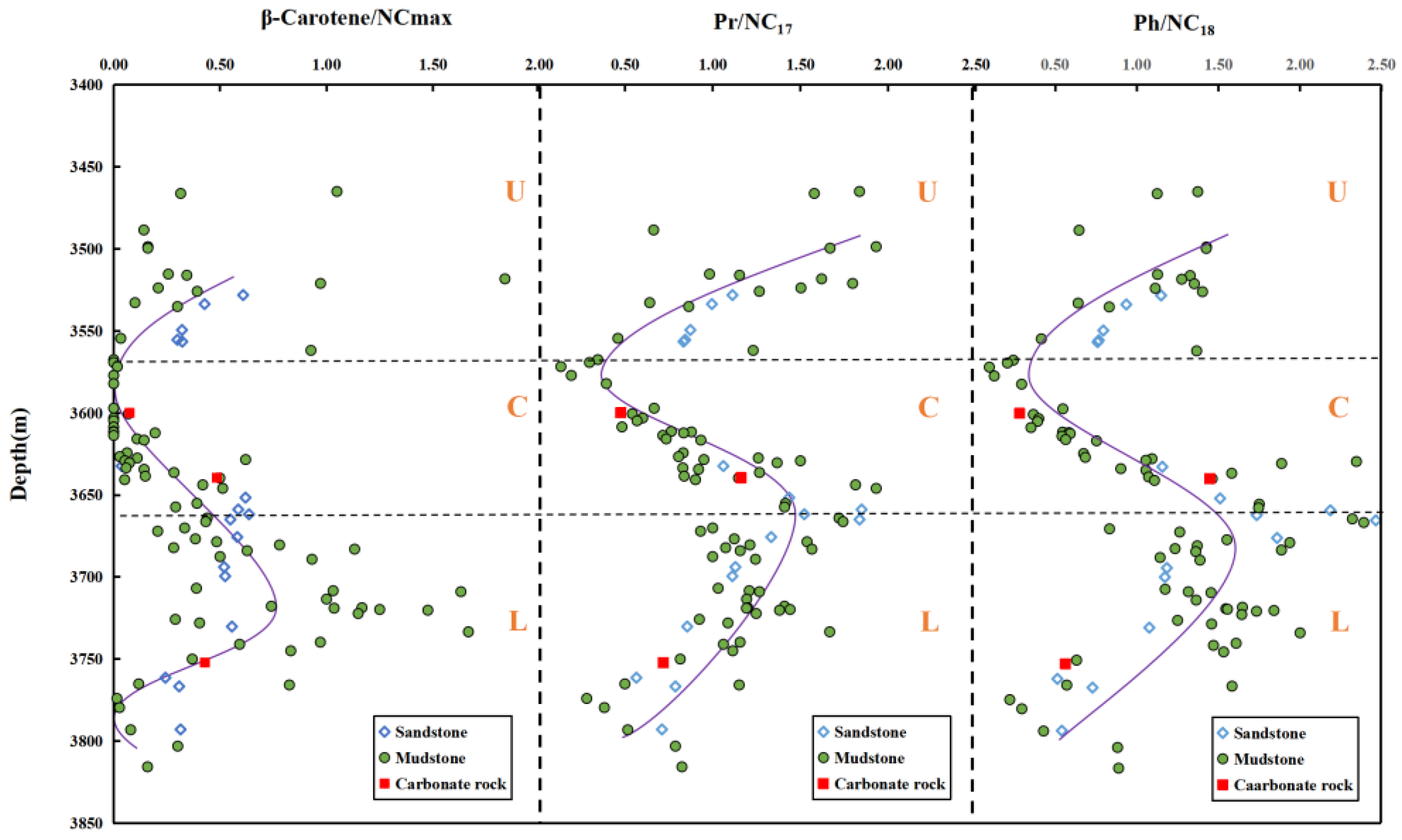
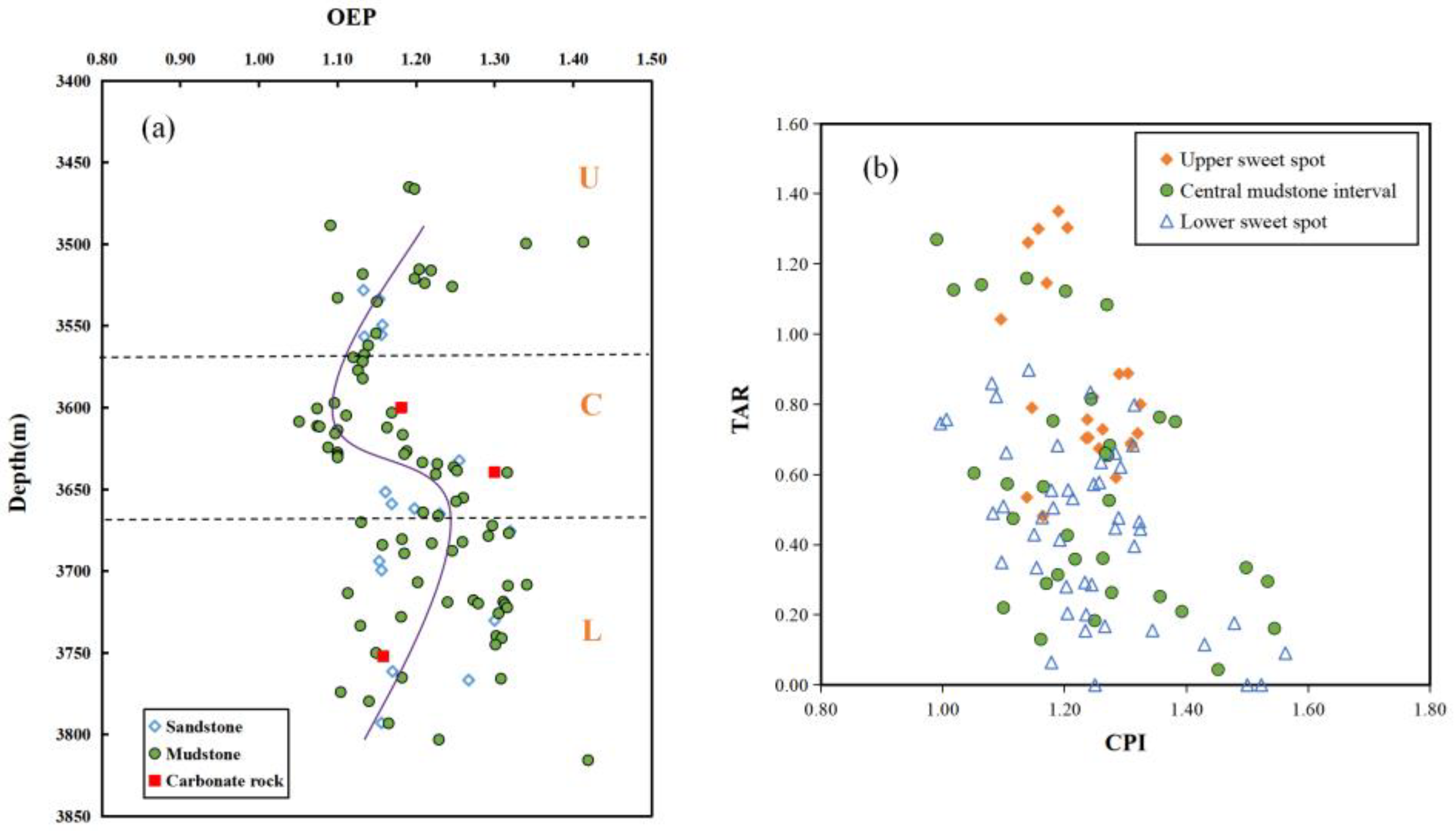

| Well | Strata | Density (g/cm 3) | Solidification Point (°C) | Viscosity (mPa·s) | Wax Content (%) |
|---|---|---|---|---|---|
| J10025 | P2l2 | 0.8868 | 18 | 34.44 | 8.4 |
| 0.8927 | 19 | 43.58 | 8.7 | ||
| 0.8834 | 16 | 32.32 | 8.7 | ||
| 0.8788 | 20 | 38 | 13.1 | ||
| 0.883 | 24 | 48.7 | 15.7 | ||
| 0.8874 | 24 | 69.7 | 16.5 | ||
| J10025 | P2l1 | 0.9189 | −1.6 | 265.7 | 3.66 |
| 0.9193 | −1.1 | 290.3 | 3.71 | ||
| 0.914 | −10 | 245.5 | 1.4 | ||
| 0.9129 | 4 | 232.5 | 3.2 | ||
| 0.914 | −9 | 196.2 | 3.31 | ||
| 0.916 | −6 | 276.8 | 2.3 | ||
| 0.9205 | −2 | 447 | 3.62 | ||
| 0.9207 | 6 | 572.21 | 4.35 | ||
| 0.9219 | −3 | 371.85 | 3.04 | ||
| 0.9219 | 0 | 419.47 | 3.85 | ||
| 0.9222 | 4 | 510.35 | 4.77 | ||
| 0.9238 | 3 | 405.96 | 4.36 |
| Clay Minerals | Quartz | Potash Feldspar | Plagioclase | Calcite | Ankerite | |
|---|---|---|---|---|---|---|
| Upper sweet spot | ||||||
| Central mudstone interval | ||||||
| Lower sweet spot |
| Upper Sweet Spot | Central Mudstone Interval | Lower Sweet Spot | |||||||
|---|---|---|---|---|---|---|---|---|---|
| Max | Mean | Min | Max | Mean | Min | Max | Mean | Min | |
| TOC (wt %) | 12.20 | 4.58 | 1.11 | 12.90 | 4.06 | 0.28 | 12.50 | 5.92 | 2.19 |
| Tmax (°C) | 449 | 445 | 440 | 450 | 442 | 435 | 452 | 443 | 427 |
| S1 (mgHC/g Rock) | 4.04 | 1.20 | 0.04 | 4.25 | 1.07 | 0.08 | 8.89 | 2.23 | 0.56 |
| S2 (mgHC/g Rock) | 82.54 | 25.12 | 0.40 | 100.49 | 24.43 | 0.20 | 78.36 | 34.98 | 10.17 |
| S3 (mgCO2/g Rock) | 0.28 | 0.07 | 0 | 0.88 | 0.23 | 0 | 1.17 | 0.31 | 0.09 |
| S1 + S2 (mgHC/g Rock) | 84.16 | 26.32 | 0.45 | 101.70 | 25.50 | 0.28 | 83.51 | 37.21 | 11.77 |
| OSI (mgHC/g TOC) | 57.08 | 21.40 | 3.60 | 80.00 | 26.28 | 8.70 | 90.69 | 35.25 | 10.33 |
| HI (mgHC/g TOC) | 822.29 | 448.41 | 28.78 | 822.69 | 496.26 | 71.01 | 906.91 | 568.04 | 292.55 |
| OI (mgCO2/g TOC) | 7.22 | 2.22 | 0 | 127.54 | 16.04 | 0 | 29.86 | 6.40 | 1.17 |
Disclaimer/Publisher’s Note: The statements, opinions and data contained in all publications are solely those of the individual author(s) and contributor(s) and not of MDPI and/or the editor(s). MDPI and/or the editor(s) disclaim responsibility for any injury to people or property resulting from any ideas, methods, instructions or products referred to in the content. |
© 2025 by the authors. Licensee MDPI, Basel, Switzerland. This article is an open access article distributed under the terms and conditions of the Creative Commons Attribution (CC BY) license (https://creativecommons.org/licenses/by/4.0/).
Share and Cite
Cheng, S.; Zou, X.; Jiang, C.; Liu, W. Characteristics of Controlling Factors of Shale Oil Enrichment in Lucaogou Formation, Jimusar Sag. Minerals 2025, 15, 469. https://doi.org/10.3390/min15050469
Cheng S, Zou X, Jiang C, Liu W. Characteristics of Controlling Factors of Shale Oil Enrichment in Lucaogou Formation, Jimusar Sag. Minerals. 2025; 15(5):469. https://doi.org/10.3390/min15050469
Chicago/Turabian StyleCheng, Sijun, Xianli Zou, Chenggang Jiang, and Weitao Liu. 2025. "Characteristics of Controlling Factors of Shale Oil Enrichment in Lucaogou Formation, Jimusar Sag" Minerals 15, no. 5: 469. https://doi.org/10.3390/min15050469
APA StyleCheng, S., Zou, X., Jiang, C., & Liu, W. (2025). Characteristics of Controlling Factors of Shale Oil Enrichment in Lucaogou Formation, Jimusar Sag. Minerals, 15(5), 469. https://doi.org/10.3390/min15050469







